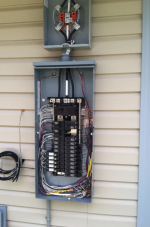Johnhall30
Senior Member
- Location
- -
- Occupation
- -
I see residential installations in my area like this all the time. Is this code compliant?
The meter can has a neutral to ground bond, which is also bonded to the meter enclosure, with a grounding electrode that goes to the ground rod, and the bonding screw installed in the main panel.
Wont this create three parallel paths from the panel to the meter enclosure? 1) The neutral 2) the bare ground and 3) the enclosure and conduit between the meter and panel

The meter can has a neutral to ground bond, which is also bonded to the meter enclosure, with a grounding electrode that goes to the ground rod, and the bonding screw installed in the main panel.
Wont this create three parallel paths from the panel to the meter enclosure? 1) The neutral 2) the bare ground and 3) the enclosure and conduit between the meter and panel


